Ad
Ad
Future of Mobility: What Should we Expect 10 years from now?
Today, when technology is player a larger role in automotive industry, it is important to discuss the future of mobility.

For the past few years, the auto industry worldwide is facing a disruption in global sales. Although, it cannot be said that the consumer demand was any less, but supply chain issues and other factors considered, the sales numbers dove sharply during the COVID-19 pandemic. Numbers suggest that the 2023 sales figures will still be lower than the 2019's total figures.
Honestly, we cannot say that people are not moving around as the enthusiasm for bikes and scooters (especially in urban areas) reflect that people are looking for alternative modes of transportation. Yes, car sales are in flux but there are other trends that are emerging such as micromobility original equipment manufacturers (eg., e-scooters, e-bikes, etc.) are pivoting to direct-to-consumer sales instead of B2B.
The mobility sharing platforms (for example, Ola, BluSmart Mobility, and BlaBlaCar) are also adjusting their business models to meet new customer demands by offering daily, monthly, or even annual rental plans.
Ad
Ad

Several underlying factors are also leading to a decrease in the amount of automobile purchases. For starters, players from other locations and industries—typically outside the conventional automobile set—are gaining traction.
The automobile business has grown more interesting to a broader range of investors, including technology firms, venture capital funds, and private equity players. Volumes of investment in automotive and transportation companies are being dominated by new stakeholders. Also, new areas, particularly in Asia, are gaining importance in vehicle manufacture.
Technology is playing a bigger role than it used to before. A tidal surge of technologically fueled megatrends is reshaping transportation. The automobile product is evolving, with electronics and software gaining significance in terms of vehicle value. Such aspects need expertise outside of the usual core capabilities of automobile engineering. Vehicle software content is expected to expand at a compound annual rate (CAGR) of 11% by 2030, accounting for up to 30% of vehicle value.
Therefore, there has been a change in the taste of what people are buying. 10 years from now we would be looking at an entirely different market that will be driven not just only on the performance of a vehicle, but on buttloads of features that comes with it.
Mobility Trends Shaping the Future
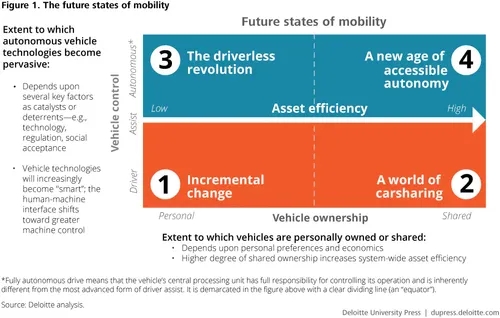
As I said earlier, the next decade or so, we are looking at a range of innovative headwinds that will change the automotive market and take it towards new horizons. Understanding that with the industry aggressively moving towards a Mobility-as-a-Service (MaaS) access model, especially when it comes to the younger generation, the OEMs and other players involved have to understand the changing consumer needs.
This change has given rise to three main verticals:
- Alternative Powertrain Options
- Electric vehicle Advances
- Popularity of on-demand service access
If we look at the current scenario, increasing urbanization, population growth and growing environmental concerns have given rise to the MaaS model. To address such problems, new mobility forms are necessary, leading to forecasts that our current vehicle-centric system of fossil fuel-powered mobility will progressively be replaced by a consumer-centric one run on electricity.
The fact is, mobility is experiencing a significant increase in investment in new technology, which is driving the industry's evolution. The primary areas of focus include e-hailing (virtually ordering a transportation service), semiconductors, and sensors, all of which contribute to the development of driver assistance systems and autonomous driving.
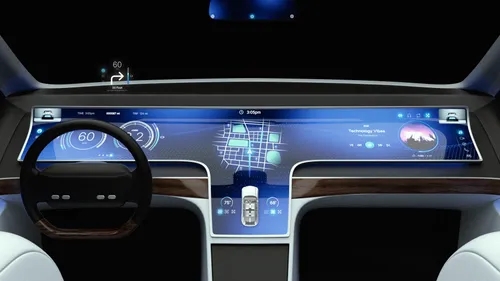
The automotive industry has been an industry driven by innovation because cars are made by a combination of multiple technologies: Chemical, Mechanical, Electrical and Digital ones.
Due to advances in processing power, data production via sensors and cameras, and low-cost data storage, automobiles are productive data centres—and increasingly—parts of broader mobility networks. Consider e-hailing services and real-time data navigation systems (such as NavIC), which provide both efficient and complementary services to existing urban transportation options.
Progress in connectivity, payment technology, and voice and gesture recognition provide opportunities for automakers to create innovative cockpits that can provide new types of content and enable in-vehicle commerce, such as in-vehicle digital wallets that allow the purchase of items directly from the car.
Moreover, Vehicle-to-Everything (V2X) technology is gaining traction, offering a broader image of a vehicle's surroundings than standard line-of-sight sensors (e.g., cameras, radar, and lidar), allowing connected items to be detected in the vicinity.
Innovative and modular designs are going to play a very important role in the coming years due to the changing function of car. And we can foresee this as many OEMs are unveiling and showcasing concept vehicles that can be used for multiple purposes.
Now that we have understood the changes that the automotive industry is going through, let’s take a look at the most riveting innovations that will take place over a decade or so:
- Electrification
- Autonomous driving
- Vehicle-to-Everything
- Mobility-as-a-Service
Electrification to Speed Up
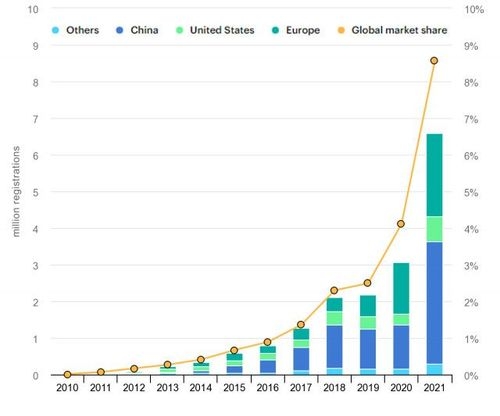
We all know that EVs are disrupting the usual ICE/Diesel/CNG dominated vehicle market and as the technology will evolve in the coming years, more new use cases will arise for the electric vehicles. Although currently EVs have conquered a small fraction of total worldwide automotive sales.
The worldwide percentage of EVs is likely to grow as government regulations increase incentives for adoption. Stricter pollution and fuel economy requirements are projected to be maintained at the national, state, and local levels, particularly in Europe and China and India is following up. Also, the cost of producing lithium-ion batteries, the most often used format, is decreasing, implying future development in manufacturing and scaled production of EVs.
Further measures to lower EV prices will undoubtedly aid mainstream consumer acceptance. Adding to that, the integration of the mobility industry with electrical networks is taking shape.
There is more access to charging infrastructure, even though EV charging can cause local constraints and stability issues on power networks—in some cases, electricity companies are attempting to use EV batteries to help stabilise grids, indicating that renewables are becoming more diffused into incumbent networks.
In the short term, manufacturers must sell enough EVs to meet stringent fleet pollution rules and fuel economy objectives while being profitable. Because of the urgency of the situation, automakers are investing in startups to grow knowledge and skills and capitalise on change.
To consolidate what I said earlier, look at what happened globally in 2019. Electric car investment broke records in 2019, with automakers spending $225 billion to build new EV models over the next several years.
Volkswagen (https://www.carbike360.com/cars/volkswagen) led the way with a $44 billion investment, with the objective of stopping the production of fossil-fuel-powered vehicles by 2026 and selling 40% EVs by 2030.
Ford also made a substantial investment, pouring $500 million into Rivian, an electric vehicle company. These are only a few instances of early investments; automakers have also spent vast sums on research, design, development, and production readiness.
The up and coming startups are more focused on improving the battery technology and shaping up the charging infrastructure. The fact that not just OEMs but other new players and other startups are just working on battery swapping technology, charging infrastructure for both public and residential use, indicates that this industry has a lot of potential.
BMW and Daimler invested in charging infrastructure company ChargePoint to help roll out charging networks for its EVs. Volvo has also made an investment in FreeWire, a business that provides silent mobile electricity and quick charging.
Let me give you another example of the potential this EV industry has , the biggest example of which is Tesla. Tesla is the pioneer in the EV area, having previously been the world's most valuable automaker, with a market capitalization of $1.2 trillion.
In early 2023, the organization was predicted to be valued at $341 billion, more than several long-standing OEMs throughout the world, including General Motors, Ford, Toyota, and Volkswagen. This demonstrates that the market and investors place a premium on innovation and the market potential for electric cars and associated goods.
It was founded in 2003, and has reached technological leadership by ideating and manufacturing a full range of EVs. Vertical and horizontal integrations into solar roofs, household batteries, and wholesale solar power plants with energy storage have expanded its knowledge base, scale initiatives, and social impact.
The Next Big Change - Autonomous Driving
The constant growth of automotive technology offers more safety benefits through Automatic Driving Systems (ADS), which might make completely autonomous automobiles a reality in the future of mobility.
During the next few years, self-driving vehicles will gradually integrate six layers of driver aid technological breakthroughs. The six levels range from Level 0, when human drivers are required to complete all driving activities, to Level 5, where vehicle ADS executes in all situations. Human drivers are still required to monitor the surroundings and conduct some activities at the intermediate levels (NHTSA).
Levels of Autonomy in vehicles:
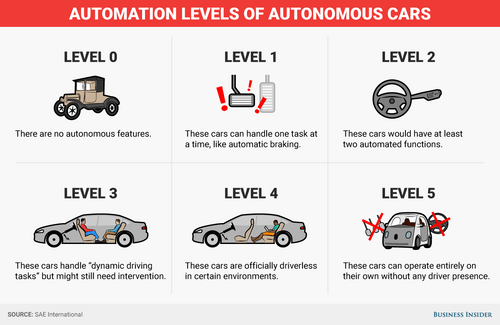
Level 0 - No Automation: Zero autonomy, driver performs all tasks.
Level 1- Driver Assistance - The driver controls the car, and some driving aid elements may be integrated in the vehicle design.
Level 2 - Partial Automation: Although the vehicle features automated capabilities like acceleration and steering, the driver must remain engaged with the driving job and observe the environment at all times.
Level 3 - Conditional Automation - Drivers are necessary, although they are not required to monitor the environment. At all times, the driver must be prepared to take control of the vehicle.
Level 4 - High Automation: In certain situations, the vehicle is capable of performing all driving tasks. The driver may be able to operate the car.
Level 5 - Full Automation: Under all situations, the vehicle is capable of performing all driving functions. The driver may be able to operate the car.
According to Next Move Strategic Consulting's market research report, the Global Advanced Driver Assistance System market size was $20.7 billion in 2021 and is expected to increase to over $75 billion by 2030, with a compound annual growth rate (CAGR) of 14.2%.
European automakers are pioneering ADAS advances, supported by advanced manufacturing capabilities and government help, such as the European New Vehicle Assessment Programme safety criteria, which encourage technological integration.
Vehicle-to-Everything: Way ahead to simplify lives
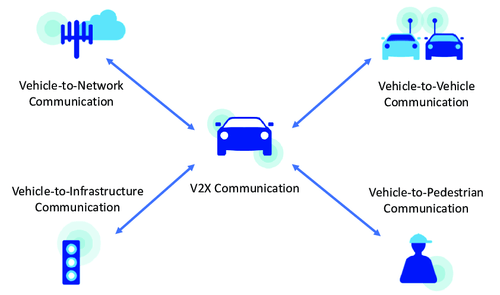
V2X stands for Vehicle-to-Vehicle (V2V) and Vehicle-to-Infrastructure (V2I) communication: wireless technology that allows cars and their surroundings to share data. V2X technology, in particular, can address the problem of sensors that cannot detect items outside the line of sight by allowing automobiles to wirelessly interact with linked devices on other cars, pedestrians, and highway infrastructure.
V2X allows automobiles to detect the movement of objects outside the field of vision when devices are linked to the same wireless network, assuring safety beyond typical line-of-sight sensors. V2X communication systems increase driver awareness of possible threats by sharing data such as position and speed with adjacent cars and infrastructure.
V2X technology can improve traffic efficiency by delivering traffic congestion alerts, alternate routes, and lower CO2 emissions via adaptive cruise control. Such technology will aid in reducing traffic and lowering individual car fuel expenses. The V2V communication sector, with its emphasis on safety measures, is expected to account for the majority of the vehicle V2X market. Vehicles equipped with V2V technology, such as the Cadillac CTS and Mercedes-Benz E-Class, are already on the road.
V2X adoption is still in its early phases; few organisations and startups are developing it, and even fewer are testing it. Automotive V2X, on the other hand, is expected to increase at a CAGR of 17.61% from 2017 to 2024, reaching a market size of $84.62 billion by 2024, up from $27.19 billion in 2017.
MaaS: Redefining Navigation

Alternative powertrains, electric vehicles, and on-demand business models are driving MaaS. Changes are promoting the replacement of the present vehicle-centric transportation system with a more efficient consumer-centric one.
Due to a rise in investor interest and quick consumer uptake, MaaS has lately extended into bikes and scooters (areas sometimes referred to as micromobility) after first focusing on ride hailing and then car sharing. Micromobility's small cars provide short-distance transportation choices for city people.
MaaS allows consumers to schedule a variety of transportation services through applications, including e-bikes, e-scooters, taxis, and public transit services in various combinations during their route. MaaS has evolved as a viable alternative to personal car ownership, and it promotes movement across cities with inadequate public transit choices in many circumstances.
Since personal automobiles remain idle for 95% of the day, MaaS platforms are arguably a more efficient mode of transportation. Shared mobility also allows users to avoid ownership expenditures such as insurance, taxes, maintenance, and parking while still getting passengers from point A to point B.
Opportunities Ahead:
Businesses and organisations should evaluate how to appropriately develop across numerous markets and sectors, as well as the structure of their supporting operational models. To design dependable solutions for moving people and products, a new mix of cross-sectoral competencies is necessary. Collaboration among participants from many industries will become increasingly important in encouraging innovation.
Change will not be led by a single firm or industry in the private sector. Instead, extraordinary collaboration will be required to build accurate and integrated mobility solutions, particularly among digital behemoths with the financial resources to fund research and innovation in these industries.
Cooperation between the public and private sectors, as represented by large high-tech firms, should be fostered as much as possible, according to the public sector. Governments should specifically encourage the growth of the four emerging trends mentioned in this article, with a focus on how to push investment into areas that may be leveraged for national advantage.
More News
Ducati XDiavel V4 Teases Ahead of Its Official Debut in India, Bookings Now Open
Ducati ignites buzz with XDiavel V4 teaser. The bike powers a 1,158 cc V4 engine, has cruiser ergonomics, and has premium features set for a January 2026 India debut. Bookings are open now.
19-Dec-2025 02:01 PM
Read Full NewsDucati XDiavel V4 Teases Ahead of Its Official Debut in India, Bookings Now Open
Ducati ignites buzz with XDiavel V4 teaser. The bike powers a 1,158 cc V4 engine, has cruiser ergonomics, and has premium features set for a January 2026 India debut. Bookings are open now.
19-Dec-2025 02:01 PM
Read Full NewsUpcoming Honda Car Launching in India in 2026
Honda accelerates into 2026 with 6 key launches blending compact SUVs, facelifts, and premium hybrids for Indian roads that promise tech, efficiency, and market outlook.
19-Dec-2025 11:07 AM
Read Full NewsUpcoming Honda Car Launching in India in 2026
Honda accelerates into 2026 with 6 key launches blending compact SUVs, facelifts, and premium hybrids for Indian roads that promise tech, efficiency, and market outlook.
19-Dec-2025 11:07 AM
Read Full NewsMaruti Suzuki Wagon R Achieved 35 Lakh Production Unit Milestone
The iconic Maruti WagonR achieves a 35 lakh production milestone, cementing its status as India's favorite hatchback with unmatched reliability and efficiency.
19-Dec-2025 07:09 AM
Read Full NewsMaruti Suzuki Wagon R Achieved 35 Lakh Production Unit Milestone
The iconic Maruti WagonR achieves a 35 lakh production milestone, cementing its status as India's favorite hatchback with unmatched reliability and efficiency.
19-Dec-2025 07:09 AM
Read Full NewsKTM 160 Duke Now Offers A 5-inch TFT Display At Rs 1.78 Lakh
The KTM 160 Duke gets a premium upgrade with a 5-inch color TFT display, bonded glass, turn-by-turn navigation and Bluetooth connectivity, priced at Rs 1,78,536 ex-showroom Delhi.
19-Dec-2025 05:26 AM
Read Full NewsKTM 160 Duke Now Offers A 5-inch TFT Display At Rs 1.78 Lakh
The KTM 160 Duke gets a premium upgrade with a 5-inch color TFT display, bonded glass, turn-by-turn navigation and Bluetooth connectivity, priced at Rs 1,78,536 ex-showroom Delhi.
19-Dec-2025 05:26 AM
Read Full NewsElectric Tata Sierra Seen Testing Ahead of Launch: Details Here
The Tata Sierra EV has been spotted testing again, confirming its electric setup and hinting at steady progress as Tata readies a new mid-size electric SUV.
18-Dec-2025 12:59 PM
Read Full NewsElectric Tata Sierra Seen Testing Ahead of Launch: Details Here
The Tata Sierra EV has been spotted testing again, confirming its electric setup and hinting at steady progress as Tata readies a new mid-size electric SUV.
18-Dec-2025 12:59 PM
Read Full NewsNew Nissan Gravite MPV Teased Ahead of India Launch in Early 2026
Nissan teases the Gravite MPV for India, a practical seven-seater focused on space, flexibility and value, marking a key step in the brand’s 2026 revival plan.
18-Dec-2025 11:49 AM
Read Full NewsNew Nissan Gravite MPV Teased Ahead of India Launch in Early 2026
Nissan teases the Gravite MPV for India, a practical seven-seater focused on space, flexibility and value, marking a key step in the brand’s 2026 revival plan.
18-Dec-2025 11:49 AM
Read Full NewsAd
Ad
Cars In India
MG Hector Plus
₹ 17.29 - 19.49 Lakh
MINI Cooper S Convertible
₹ 58.50 Lakh
Mahindra XEV 9S
₹ 19.95 - 29.45 Lakh
Tata Sierra
₹ 11.49 - 21.29 Lakh
Porsche Cayenne EV
₹ 1.76 - 2.26 Cr
Kia New Seltos
₹ 10.99 - 20.80 Lakh
Mahindra 7XO
₹ 14.00 - 26.00 Lakh
Maruti e Vitara
₹ 20.00 - 25.00 Lakh
Nissan Gravite
₹ 6.20 - 9.00 Lakh
Hyundai Ioniq 5 Facelift
₹ 36.37 - 46.36 Lakh
Ad
Ad
Ad